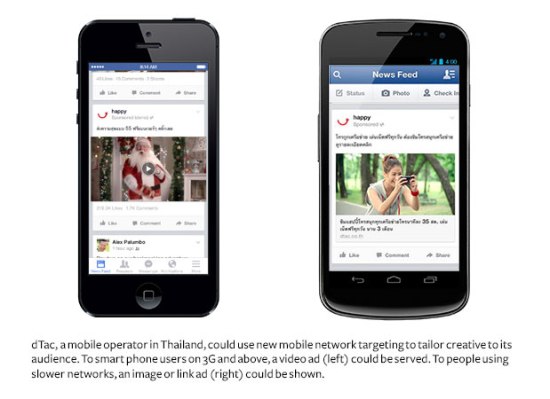Facebook today counts more users, and faster growth, outside of its home market of the U.S. than inside it, but the U.S. still accounts for nearly half of all the social network’s ad revenues. To help boost the ratio in emerging, rapidly expanding markets, where mobile devices are the primary means for going online, today Facebook said it would turn on a new piece of ad tech called bandwidth targeting: bandwidth targeting will give advertisers the ability to send ads based on the quality of a user’s network connection, moderating type of ad to whether a user is on a 2G, 3G or 4G / faster connection.
An illustration of how ads could look in practice, trialled on services in Thailand, is above.
Facebook said that the feature is rolling out globally starting today through its Ad Create tool, Power Editor and the API.
That means that technically, bandwidth targeting could also be used in markets like the U.S. to, say, serve rich media ads to people on 4G connections, while giving those on slower phones and less connectivity, a more pared-down, less annoying experience.
Still, according to a post by Facebook product marketing manager Brendan Sullivan about the new feature, bandwidth targeting is mainly aimed at more developing regions, where Facebook has already been honing its growth sights.
The move to add bandwidth targeting comes in the wake of Facebook already allowing advertisers to target based on device type, device model and operating system. Sullivan explains the rationale for adding bandwidth like this:
“Targeting by mobile network type helps advertisers choose creative that will run smoothly on any given device and connection speed. For example, serving a video ad to people in Indonesia with 2G connections may mean wasted impressions if people are unable to load the video or it buffers for minutes when clicked. Optimizing the creative — for instance, targeting a video campaign to people with high-speed connections, and swapping in an image or link ad for people with slower connections — means ads can perform more efficiently for the people seeing them.”
It’s also part of a bigger strategy at the company to localise services and make them more accessible to users in markets outside of developed, mature countries like the U.S. and markets in Western Europe.
On top of initiatives like Internet.org that aim to work on improving Internet access for people, Facebook has been working on ways of making the social network more accessible on mobile devices through different kinds of data plans. Earlier this year, the company acquired Pryte in Finland, which works as a middle man between carriers and content companies to create data plans based on access to specific content — or perhaps in the case of Facebook, access to Facebook free of charge. In 2013, it acquired Onavo, a mobile analytics specialist, that was partly a bolster to its Internet.org initiative. Onavo’s technology, which was able to detect characteristics of users’ handsets such as what kind of device you are on, may be getting utilized in the new targeting tool, too.
Mobile is very big business for Facebook right now. According to the company’s last quarterly earnings announced in July, there were 1,070 million monthly active users of Facebook coming in on mobile devices, while the bigger figure, including mobile and desktop, was 1,317 million.
Within that bigger figure, Asia and “rest of the world” is already massively outnumbering the U.S. and Europe in terms of usage, which together account for only 496 million monthly active users across all devices. Facebook says it now has 399 million users who only access the social network on mobile devices, but it doesn’t break out regional proportions behind the number.
At the same time, though, Asia and other countries outside of the U.S. and Europe are well under Facebook’s mean average revenue per user figure, and most definitely below what Facebook earns from users in the U.S. Facebook is currently making ARPU of $5.79 per user in its home market, while Asia is just $1.02 and ROW is $0.83. The global average is $2.06. Adding in a feature that could help better connect users to ads based on bandwidth may not only mean serving more ads, but also encouraging advertisers to push more ads to those users.
Countries like India, which have already passed the 100 million user mark, are on target to be Facebook’s biggest single countries in terms of users. Here, while smartphone use (fuelled by the rise of sub-$50 devices) is most definitely on the rise, feature phones are still very popular, and so are slow connections. It comes as no surprise that one of the advertisers trialling this service is Vodafone in India, “with good early results.”
“We are excited about the new mobile targeting option on Facebook which allows us sharper targeting to a relevant audience,” Ronita Mitra, SVP, Brand Communication, Insights and Online, Vodafone India, in a statement. “We hope to see more such technology innovations across the industry.”
